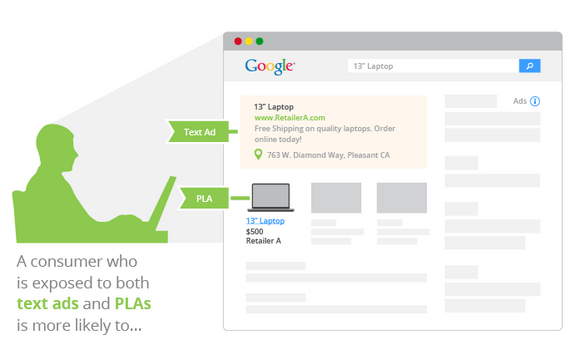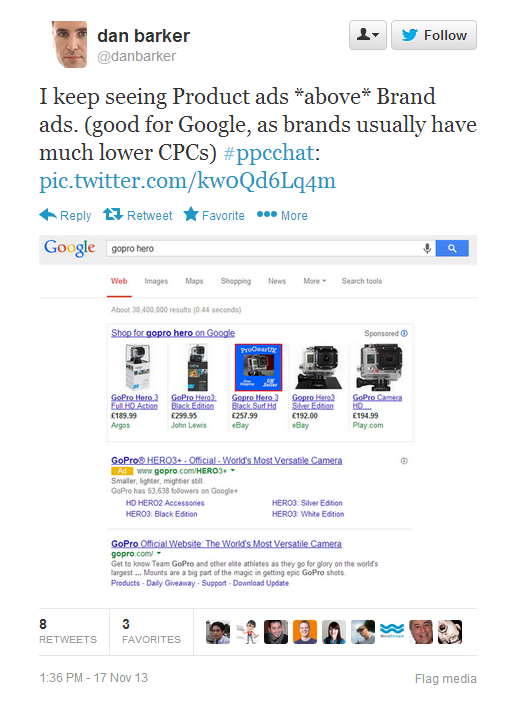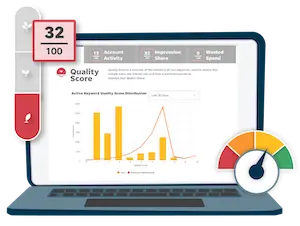
Text ads and Product Listing Ads (PLAs) are more powerful used together, according to Google; in fact, using text ads alone means lower brand recognition, less site engagement and fewer online sales, they say.
Google’s recent study, conducted in cooperation with research and consulting firm Millward Brown, shows that:
- People who see a brand’s PLAs and text ads are 75% more likely to search for that brand within 30 days than those who only saw text ads.
- People who see both text ads and PLAs are 90% more likely to visit the retailer’s website. They are also more likely to visit product pages, add items to their cart, and click on store locator buttons.
- People who see both text ads and PLAs are 83% more likely to make a purchase than those who only saw text ads.
Their findings pertain mostly to technology shoppers, Google admits, though they believe the positive results of PLAs and text ads used in tandem apply to other shoppers, as well.
According to Google, PLAs and text ads used together also make consumers 70% more likely to click on the store locator and 42% more likely to visit a product page. However, it’s worth noting Google is only speaking about major apparel retailers who sell their own brands with respect to these statistics.
The timing of this particular study is quite intentional, as retailers gear up for a holiday season that should see e-commerce take a greater share of holiday sales than ever before.
This is all great news, right? There’s the secret to boosting your holiday sales, right there: more ad spend on both text ads and PLAs.
Yet just a year ago, Google’s research focused on convincing marketers that the relationship between text ads and organic results was a positive one – in other words, that text ads were not cannibalizing organic search results. At that time, they told us that 89% of traffic generated by ads was not replaced by organic clicks when ads were paused.
RELATED: Do AdWords Shopping Campaigns Work?
Google PLAs Crowd Out Organic Search Results
In 2012, showing up in the top paid search and organic search spots was the magic formula for increased traffic, intent and conversion. What’s changed?
Simply, there’s very little room left for organic results above the fold. Google’s placement of PLAs means that about 80% of the screen is now consumed by paid advertising. Earlier this year, Larry Kim referred to PLAs as “commercial intent-sucking monsters … stealing all the conversions from both the organic and non-PLA search results.”
Higher intent shoppers are drawn to PLAs, he explained; the graphic ads, including pricing information and leading straight to e-commerce landing pages, make it simple for people at the end of the funnel to convert. Were those who scrolled past the text ads and PLAs to organic listings ever going to convert at all? They’re far more likely to be in exploratory mode, searching for information rather than a quick buy.
It’s difficult to put stock in Google’s research results, as they seem to simply reinforce what we knew we would see when they bumped all of the organic results down the page. If there are eight ads on the page and two of them are yours, logically, you have a greater chance of getting a click than the guy who only has one.
When Larry attended Search Insider Summit this summer, it was relatively early days for PLAs, yet big-brand PPC managers were already reporting that PLAs were performing incredibly well – at the expense of their text ads. And now Google seems to be running tests that give PLAs even more prime real estate.
Image: Dan Barker on Twitter
We know that 53% of organic clicks go to the first link (Compete, 2012). If you’re not there and don’t have the budget to run both PLAs and text ads in the top positions, what eyes are left for your organic or paid search results? As of Q1 last year, Google told us that 81% of the time, when a paid ad is displayed, there is no corresponding organic listing on the first page.
At any given time, there are a finite number of consumers searching for any given product, each with their own level of intent. As Google continues to present those ready to purchase with paid options over organic, we don’t need affirmation that paid is working. It’s not even surprising that more paid works even better. This is to be expected.
Google’s latest findings work only for major brands with the budget to play at the top of both AdWords text ads and PLAs. Smaller companies who have to choose between text ads and PLAs for budget reasons should prepare to be left in the cold this holiday season.









